Rohan Clarke looks back on two decades with Australian Golf Digest and shares his views about the game then and now.
IT was a chance meeting with the late Phil Tresidder that led to what has become a 20-year association with Australian Golf Digest. What began as a small exercise to research Greg Norman’s playing record for his 1993 book, The Shark Bites Back, evolved into an offer to join the magazine as its assistant editor in 1995. It’s been a privilege to be associated with Australian Golf Digest over the course of this journey. A lot has changed at the magazine over two decades. Back in 1995, the production and design of Australian Golf Digest was done in our Sydney office at Alexandria near Sydney Airport. Colour separations were performed in Singapore, while the magazine was printed at Dubbo in NSW’s Central West. It meant long ‘lead’ times and the need to be topical rather than news-orientated. Digital photography was still in its infancy and therefore staff photographers used traditional cameras that captured light on photographic film. Pictorial material from Golf Digest (US) came in the form of duplicate colour transparencies, which lacked the sharp resolution of today’s digital images. American articles could be scanned, although it was often easier to type them in. One of the more vivid recollections came when editorial director Barry Tranter assured me the editorial process would be simpler in the future as, “We’ll be getting this thing called ‘email’.” I remember thinking, Yeah, right. I’m sure that’ll make a big difference!
THE NORMAN ERA
No figure in Australian golf has been as influential as Greg Norman. His on-course persona and playing style resonated with Australian golfers. The Great White Shark’s success inspired people to play golf and join a club. Sales of golf equipment rose markedly, while magazine sales lifted when Norman appeared on the cover.
The blackest day in Australian golf occurred on Monday, April 15 1996 when we tuned into the Channel 9 coverage and saw Norman surrender a six-stroke lead, handing Nick Faldo a third Masters title. In tearooms around the country (I don’t think we had water coolers back then), non-golfers consoled us and wanted to know how this one got away.
Norman rebounded and received our Player of the Year for the third time in the 1990s. In a bumper December 1997 issue, full-page advertisements bore his image – Greg Norman Collection, Sanctuary Lakes Resort, Cobra Golf, Maxfli, Holden, The Grand Golf Club and a five-page advertorial about Pelican Waters (written by The Shark’s long-time antagonist Tom Ramsey).
Mr Tresidder was rather chuffed with the issue, which included a lengthy Q&A with Ben Hogan and Tom Callahan’s award-winning feature ‘In Search Of Tiger Phong’, which followed the trail of the war hero who inspired a father’s famous son. But the feedback from our proprietor wasn’t quite what Phil anticipated. Word came back from Michael Hannan that, “You should make Greg Norman the Player of the Year, every year.”
To think we had to wait a further 6,209 days for redemption – on the brightest day in Australian golf (Monday, April 15 2013) when Adam Scott ended a nation’s heartbreak to become the first Australian to don the green jacket.
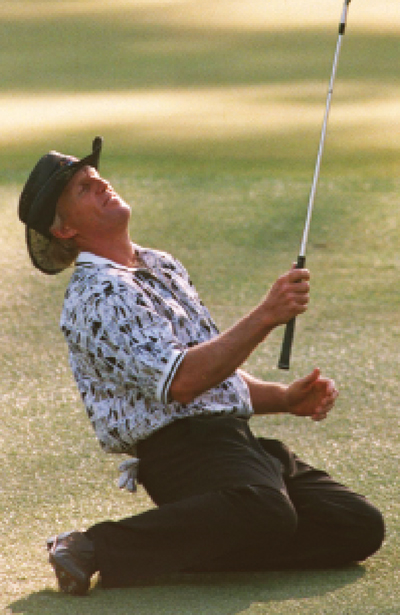
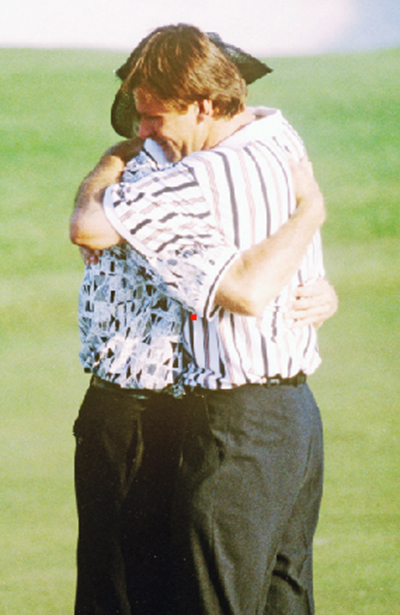
The Blackest Day in Australian Golf: We awoke on Monday, April 15, 1996 hoping to see the coronation of Greg Norman as the first Australian to win The Masters. Instead, we watched in horror as he surrendered a six-stroke lead to gift Nick Faldo a third green jacket. Left: The pair embraced on the final green where the Englishman told Norman, “Don’t let the bastards get you down” . . . We assume Faldo meant us, the media.
YOUTH TRUMPS EXPERIENCE
The most significant moment of the past 20 years came when Tiger Woods won the 1997 Masters, breaking racial barriers as the first black man to win a major in a sport dominated by white males. The achievement transcended golf. But it was the manner in which Woods dominated the field that was astonishing. He triumphed by a staggering 12 strokes to become the youngest winner of The Masters at age 21. Professional golf was meant to be a sport where players had to learn the skills and acquire the experience to master it and win majors. Jack Newton often remarked that Australian professionals took longer to mature, not reaching the peak of their powers until the early-to-mid 30s. And that is true of Newton, Norman, Wayne Grady, Ian Baker-Finch, Steve Elkington, Geoff Ogilvy and Scott. But Woods defied accepted wisdom, ushering in a fearless generation of young golfers now led by Rory McIlroy and Jordan Spieth.
I find it almost inconceivable that a 17-year-old Korean-born New Zealander has become the youngest person to be ranked No.1 in professional golf. Lydia Ko was born 11 days after Woods’ watershed moment at Augusta National.
Standing just 165cm (5-foot-5), Ko has been capturing titles since the age of 14 when she became the youngest winner of a professional event with her Women’s NSW Open victory at Oatlands Golf Club in Sydney. Just months later, a 14-year-old Canadian, Brooke Henderson, broke that record by winning on the Women’s Canadian Tour.
Flicking through the LPGA Tour Media Guide in 1995, I seem to recall that most players were aged over 30 and a substantial number were older than 40. I can’t recall a player in the early 20s, let alone a teenager. Along came Michelle Wie, who competed on the US PGA Tour as a 14-year-old via a sponsor’s exemption at the 2004 Sony Open in Hawaii. She missed the cut by a single stroke after shooting 72-68 against the men.
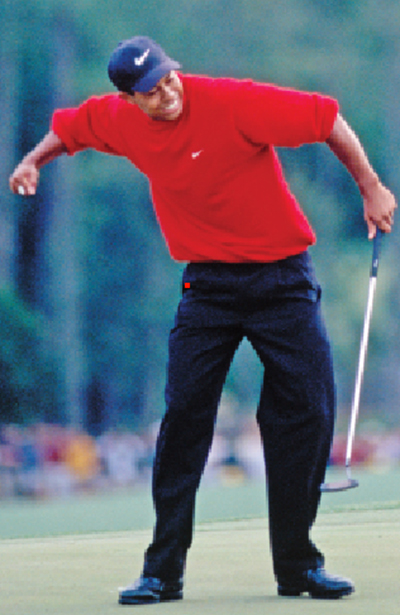
THE EQUIPMENT EVOLUTION
What has made it possible for teenagers to play the game at an elite level is modern equipment. As seven-time major winner Karrie Webb explains: “I think the popularity of golf has increased and so therefore the technology with equipment, but also the technology of teaching.
“I think kids are getting taught correctly at a younger age with equipment that fits them. They’re not starting with heavy cut-down clubs. They’ve got clubs that are specifically weighted for someone that’s seven or eight years old.”
Graphite shafts and lightweight titanium clubheads have been at the forefront of the equipment evolution. Clubheads and sweet spots have become larger, while clubfaces have become thinner. The sport’s governing bodies were forced to act on the distance the ball is travelling by putting limits on the spring-like effect of modern clubs.
Traditional wound balls have made way for multi-layer balls with a solid core, which provide distance off the tee and feel around the greens. Another significant innovation came with the introduction of rescue clubs (pioneered by Adams Golf and TaylorMade), which make it easier to get the ball airborne. It’s not unusual to see a 5 or 6-iron as the longest iron in the bag of many female players.
One sound I miss is the crackling of metal spikes on the pavement surrounding the clubhouse. Plastic cleats are said to have made turf maintenance easier for greenkeepers, and general managers as there is less wear and tear on carpets and flooring. Comfortable, rubber-teated footwear allows for the convenience of driving to and from the golf course without having to change shoes. But walking to the first tee used to have a sense of occasion, like walking out to bat or trotting out onto the football field.
Golf fashion has undergone a massive transformation in less than two decades. Polo shirts used to sag with sleeves that ran down to the elbows. Trousers weren’t much better, more along the lines of Bombay bloomers. One attempt to place John Daly on the cover was met with disapproval by our female GM. “Baggy pants,” she exclaimed with indifference towards his post-impact position. All she could see was the flared pants. I think we changed the image but still went with the main coverline, ‘Golf’s Bad Boy’. Perhaps Golf’s Baggy Boy may have been appropriate.
The shapes of professional golfers have altered considerably with a focus upon golf-specific fitness. Conventional wisdom used to dictate that great golfers have short arms like Jack Nicklaus. But modern equipment has made that statement redundant and we’ve seen powerfully built, tall athletes such as Ernie Els, Vijay Singh and Dustin Johnson. It’s now seen as a distinct advantage to have long levers and the strength to swing a golf club efficiently. And it’s rare nowadays for golfers to be derided as athletes.
Flat bellies are in, pot bellies are out. So, too, are belly putters, which face extinction after the R&A and USGA proposed a rule that would prohibit the anchored-style of putting. The November 2012 decision came after Els used a belly putter to snatch the 2012 British Open, which followed victories at the 2012 US Open by Webb Simpson and 2011 PGA by Keegan Bradley. Scott’s subsequent triumph at the 2013 Masters meant four of six majors had been won using a long or belly putter.
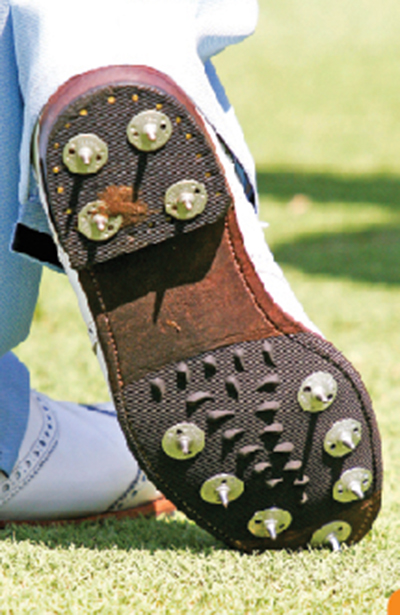
PROFESSIONAL GOLF GOES GLOBAL
With golf expanding beyond the Anglosphere, it stands to reason Australia won’t have the sustained success it has enjoyed over the past 70 years, netting 16 men’s majors, 10 women’s majors and hundreds of tournament victories on foreign soil. But just as Australian tennis and swimming have become accustomed to greater international competition, Australian golf must get used to a global environment.
That said, it’s never been easier for elite Australian golfers to pursue a professional career overseas. The hard part is establishing and sustaining a career with some sort of longevity. Golf Australia (with the financial support of the Kinghorn Foundation) has established a Rookie Program to make the transition easier into the professional ranks, providing up to $100,000 per year for squad members.
Since Arnold Palmer revolutionised the sport in the 1960s, the US PGA Tour has been the ultimate destination for aspiring players. What has changed for Australians is the pathway. Back in the 1990s, our top players were advised to establish themselves in Europe before thinking about America. It was a well-worn path taken by Norman, Baker-Finch, Craig Parry, Robert Allenby and Scott.
Young Australians now aim for the stars and bypass Europe in the quest of playing the US PGA Tour. Stuart Appleby was probably the first to do so without taking the precautionary step of spending a couple of years playing college golf. The formation of the Web.com Tour (formerly the Hogan Tour and Nationwide Tour) has allowed an alternate route for players the ilk of Paul Gow and Anthony Painter to have a crack at the big show, rather than wasting time playing the Australian pro-am circuit. Rather than go to Europe, Australian rookies are increasingly looking to Asia to get their start. Cameron Smith is the most recent example and more are likely to follow since the establishment of the PGA Tour China Series, which gives the top-five money-winners a card onto the Web.com Tour.
At home, the PGA Tour of Australasia has consolidated. The Australian Open, Australian PGA, Australian Masters, Perth International, New Zealand Open and Fiji International each have million-dollar purses. They form the core of a 15-event circuit that is supplemented by state Opens and PGAs.
Former tour players hark back to the glory days of the 1980s and 1990s when they regularly played up to 20 events with better prizemoney. But you have to ask if that made them comfortable. At one stage in the mid-1990s, there were only four Australians playing fulltime in America. That number now exceeds 30.
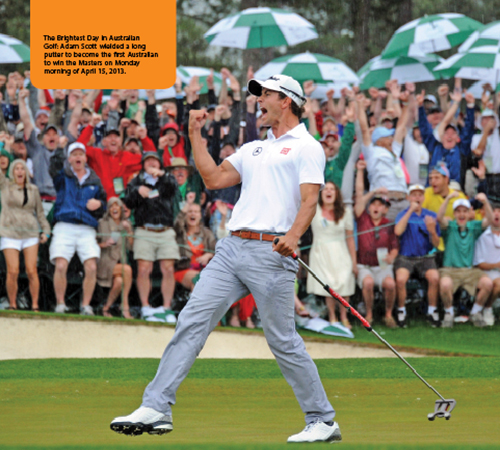
GOLF IN HIGH-DEFINITION
The past 20 years has seen a massive transformation in how people watch golf. In the mid-1990s, Australia’s commercial television networks provided that fix, broadcasting the four majors as well as the domestic ‘Summer of Golf’. The berth of pay-TV operator Foxtel has allowed the US PGA Tour to be beamed into homes on a weekly basis. The viewing experience has become irresistible as we’ve become accustomed to high-definition TV, slow-motion replays and shot-tracking technology.
Woods was a magnet for the sport, generating huge TV ratings and corporate support for the US PGA Tour. The cumulative effect was higher broadcast fees and greater sponsorship. Prizemoney at a regular US PGA Tour event such as the Pebble Beach National Pro-Am has more than quadrupled since 1995, increasing from $US1.4 million to $US6.8 million (485 per cent).
And where the US PGA Tour used to conclude with a Tour Championship in September, it now extends for 11 months of the year. What was once envisaged as a ‘World Tour’ by Norman has become an American Tour with world-class players (who, in the case of Scott and Justin Rose, choose to base themselves in exotic locations like The Bahamas where the sun shines and the tax scheme is just as sunny).
The downside of the growth in US Tour purses has been the detrimental effect it’s had on feeder circuits like the PGA Tour of Australasia. Top foreign players don’t need to come Down Under. When they do, their agents demand six-figure appearance fees to tee it up.
It was disappointing Australians didn’t get to see Woods in the flesh at the height of his powers between 1999-2008. Hence, his long-awaited return for the 2009 Australian Masters at Kingston Heath remains the most successful tournament held in this country. In a marketing coup, Victorian taxpayers coughed up half of the $3 million appearance fee. By week’s end, the tournament was estimated to have generated $34 million for the State’s economy.
Just weeks later, Woods’ career nosedived after revelations of an extramarital affair, a collision with a fire hydrant outside his Florida home and then further revelations of affairs with more than a dozen women.
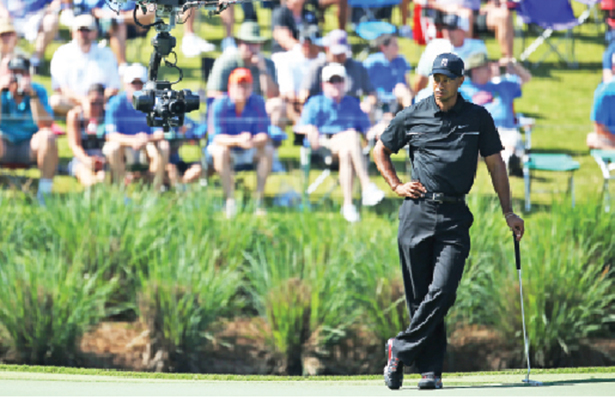
THE INDUSTRIAL AGE OF COURSE DESIGN
From the mid-1990s we began to witness the ‘Golf Course Living’ phenomenon. Course construction proliferated on the back of developers building residential estates around golf courses. Some of the more notable projects include: Macquarie Links, Stonecutters Ridge, Twin Creeks (Sydney), The Vintage (NSW Hunter Valley), Magenta Shores (NSW Central Coast), Sandhurst Club, Sanctuary Lakes, The Heritage (Melbourne), The Sands, Thirteenth Beach (Victoria’s Bellarine Peninsula), Brookwater, North Lakes (Brisbane), Lakelands, The Glades (Gold Coast), Noosa Springs and Pelican Waters (Sunshine Coast). Whilst sustainability for some is an on-going challenge, these projects certainly changed the golf landscape, introducing a new experience to Australian golfers.
Golf-course construction was flourishing in America during the mid-to-late-1990s when more than 600 new layouts were opening every year – almost two per day on average. Perhaps it was inevitable a downturn would occur, but after the Global Financial Crisis the industry has seen net closures – more courses closing than opening in America.
In Australia, residential golf developments have slowed dramatically because of huge challenges facing developers. Basically, they need a suitable location, such as the urban fringes of larges cities. However, the increasing value and scarcity of land make this problematic, while tighter planning laws add to the front-end coast and impact a project’s feasibility.
Hence, course architects both in Australia and America have looked to Asia for business. Golf was already well established in the Northern Asian markets of Japan and Korea. The past two decades has seen course construction thrive across Southeast Asia in Thailand, Malaysia, Indonesia, Vietnam and Cambodia.
But it’s been the industrialisation of China that has kept architects busy. It wasn’t so long ago that golf was banned there under Chairman Mao because the game was associated with wealth and Western elites. Today, more than 600 courses exist. However, the boom may have reached its peak as China’s Communist rulers cracked down hard on construction, closing 66 illegally built courses. Authorities ordered a national moratorium in 2004 (citing water and environmental concerns) when there were fewer than 200 courses. But developments continued unabated, often unsanctioned.
But it would be wrong to draw a conclusion that golf is frowned upon in China. Earlier this year came news that Woods is to be paid $US16.5 million to design a course in Beijing. Meanwhile, China’s development program for elite golfers continues as the country ramps up its pursuit of Olympic medals.
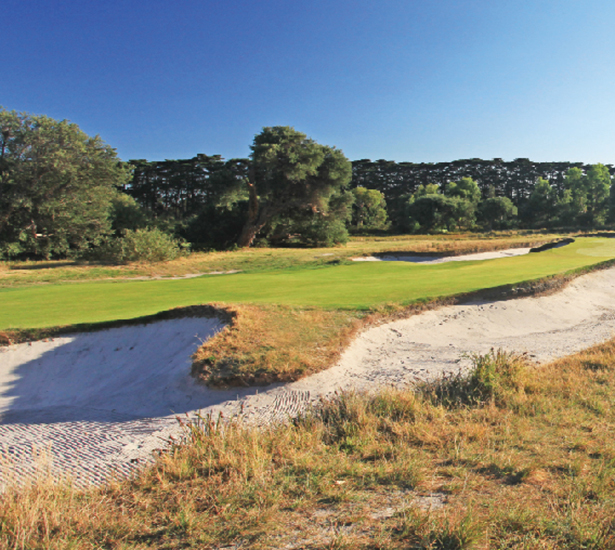
THE RISE OF THE INTERNET
If not for the Internet (and The Presidents Cup), I wonder if the Melbourne Sandbelt would have as many admirers. The ability to discover more about a subject simply by typing a word into Google has allowed us to become knowledgeable about unfamiliar topics. In this regard, the reputation of Royal Melbourne has grown to the point where it is held in the company of the Old Course at St Andrews, Augusta National and Pine Valley. Royal Melbourne has had a substantial influence on architecture. Foreign designers have paid homage to its unique style of bunkering from China (Schmidt-Curley’s Sandbelt Trails at Mission Hills Hainan) to Brazil (Gil Hanse’s new Olympic course in Rio).
Meanwhile, it is not unusual for tour players to have their own websites. They can interact with their fans on social-media platforms such as Facebook and Twitter (sometimes with unintended consequences in the case of Elkington).
In publishing, we’re seeing how the digital world has impacted upon the traditional print version of magazines. Australian Golf Digest is now available in tablet format, enabling golfers to subscribe through the App Store and Google Play. It will be interesting to see what other changes occur over the next 20 years.
Global Connection: Allowing us to become knowledgeable about unfamiliar topics, the Internet has made the world a smaller place and helped to popularise the Melbourne Sandbelt and Royal Melbourne Golf Club.




